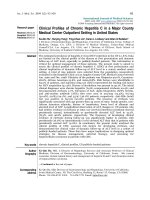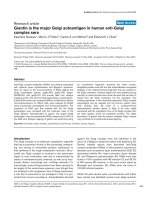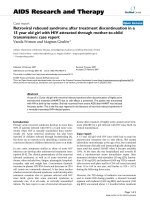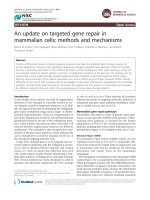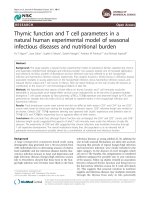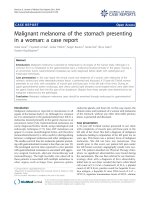Báo cáo y học: " intensive care unit-acquired urinary tract infections in a regional critical care system" ppt
Bạn đang xem bản rút gọn của tài liệu. Xem và tải ngay bản đầy đủ của tài liệu tại đây (156.38 KB, 6 trang )
Open Access
Available online />R60
February 2005 Vol 9 No 2
Research
Intensive care unit-acquired urinary tract infections in a regional
critical care system
Kevin B Laupland
1
, Sean M Bagshaw
2
, Daniel B Gregson
3
, Andrew W Kirkpatrick
4
, Terry Ross
5
and Deirdre L Church
6
1
Assistant Professor, Departments of Critical Care Medicine, Pathology and Laboratory Medicine, and Community Health Services, Center for Anti-
microbial Resistance, Calgary Health Region, Calgary Laboratory Services, and the University of Calgary, Calgary, Alberta, Canada
2
Fellow, Departments of Medicine and Community Health Services, Calgary Health Region, Calgary Laboratory Services, and the University of
Calgary, Calgary, Alberta, Canada
3
Associate Professor, Departments of Pathology and Laboratory Medicine, and Medicine, Calgary Health Region, Calgary Laboratory Services, and
the University of Calgary, Calgary, Alberta, Canada
4
Clinical Assistant Professor, Departments of Critical Care Medicine, and Surgery, Calgary Health Region and the University of Calgary, Calgary,
Alberta, Canada
5
Analyst, Center for Anti-microbial Resistance, Calgary Health Region, Calgary Laboratory Services, and the University of Calgary, Calgary, Alberta,
Canada
6
Professor, Departments of pathology and Laboratory Medicine, and Medicine, Calgary Health Region, Calgary Laboratory services, and the University
of Calgary, Calgary, Alberta, Canada
Corresponding author: Kevin B Laupland,
Abstract
Introduction Few studies have evaluated urinary tract infections (UTIs) specifically acquired within
intensive care units (ICUs), and the effect of such infections on patient outcome is unclear. The
objectives of this study were to describe the occurrence, microbiology, and risk factors for acquiring
UTIs in the ICU and to determine whether these infections independently increase mortality.
Methods A surveillance cohort study was conducted among all adults admitted to multi-system and
cardiovascular surgery ICUs in the Calgary Health Region (CHR, population about 1 million) between
1 January 2000 and 31 December 2002.
Results During the 3 years, 4465 patients were admitted 4915 times to a CHR ICU for 48 hours or
more. A total of 356 ICU-acquired UTIs (defined as at least 10
5
colony-forming units/ml of one or two
organisms 48 hours or more after ICU admission) occurred among 290 (6.5%) patients, yielding an
overall incidence density of ICU-acquired UTIs of 9.6 per 1000 ICU days. Four bacteremic/fungemic
ICU-acquired UTIs occurred (0.1 per 1000 ICU days). Development of an ICU-acquired UTI was more
common in women (relative risk [RR] 1.58; 95% confidence interval [CI] 1.43–1.75; P < 0.0001) and
in medical (9%) compared with non-cardiac surgical (6%), and cardiac surgical patients (2%). The
most common organisms isolated were Escherichia coli (23%), Candida albicans (20%), and
Enterococcus species (15%). Antibiotic-resistant organisms were identified among 14% isolates.
Although development of an ICU-acquired UTI was associated with significantly higher crude in-
hospital mortality (86/290 [30%] vs. 862/4167 [21%]; RR = 1.43; 95% CI 1.19–1.73; P < 0.001);
an ICU-acquired UTI was not an independent predictor for death.
Conclusions Development of an ICU-acquired UTI is common in critically ill patients. Although a
marker of increased morbidity associated with critical illness, it is not a significant attributable cause of
mortality.
Keywords: incidence, intensive care unit, mortality, urinary tract infection
Received: 12 November 2004
Accepted: 23 November 2004
Published: 6 January 2005
Critical Care 2005, 9:R60-R65 (DOI 10.1186/cc3023)
This article is online at: />© 2004 Laupland et al.; licensee BioMed Central Ltd.
This is an Open Access article distributed under the terms of the
Creative Commons Attribution License ( />licenses/by/2.0), which permits unrestricted use, distribution, and
reproduction in any medium, provided the original work is properly
cited.
APACHE = Acute Physiology and Chronic Health Evaluation; CHR = Calgary Health Region; CI = confidence interval; CVICU = cardiovascular sur-
gery intensive care unit; ICU = intensive care unit; IQR = inter-quartile range; RR = relative risk; UTI = urinary tract infection.
Critical Care February 2005 Vol 9 No 2 Laupland et al.
R61
Introduction
Infection of the urinary tract (UTI) is the most common hospital-
acquired infection in North America and is among the most fre-
quent nosocomial infections in critically ill patients [1-4]. Noso-
comial UTIs have been associated with a threefold increased
risk for mortality in hospital-based studies, with estimates of
more than 50,000 excess deaths occurring per year in the
USA as a result of these infections [5]. Furthermore, in several
studies nosocomial UTIs have been associated with increased
length of hospital stay and cost [6,7]. Despite their impor-
tance, there have only been very limited studies focused on
nosocomial UTIs in the critically ill. Richards and colleagues
reported on intensive care unit (ICU) nosocomial infections in
the National Nosocomial Infections Surveillance System
(NNIS) database and found that UTI was responsible for 20–
30% of nosocomial infections in medical/surgical ICUs [1,8].
Finklestein and colleagues determined an incidence of 10–14
UTI per 1000 catheter days among 337 patients in a single
Israeli ICU [9]. Rosser and colleagues retrospectively
reviewed 126 trauma ICU patients with sepsis and found that
increased length of stay, length of catheterization, and age
(more than 60 years) were independent factors associated
with the development of nosocomial UTI [10]. These studies
were limited in part either as a result of being conducted in
specialized ICUs or critically ill patient subsets, by small sam-
ple size, or by limited assessment of outcome.
We previously conducted a study of all patients admitted to
multidisciplinary ICUs in the Calgary Health Region (CHR)
during a 1 year period and found that increased length of stay
and female gender were independently associated with the
acquisition of these infections [2]. However, this study was
limited by exclusion of many cardiovascular surgery patients
and like other investigations had insufficient statistical power
to detect a clinically important increased risk for mortality asso-
ciated with ICU-acquired UTIs [11]. We therefore conducted
further surveillance among all critically ill adults in the CHR to
better delineate the occurrence, microbiology, and risk factors
for acquiring ICU-acquired UTIs and determine whether these
infections increase the risk for mortality.
Methods
Study population
The CHR administers all acute hospital care to the residents
of the cities of Calgary and Airdrie and several large adjacent
regions (population about 1 million). All ICUs within the CHR
are closed units staffed by fully trained intensivists and are
administered by the Department of Critical Care Medicine,
University of Calgary, and CHR. These include a 14-bed car-
diovascular surgery ICU (CVICU) and multidisciplinary ICUs
(total 44 beds) at each of the three adult acute care centers in
the CHR. All patients 18 years of age and older admitted to an
adult multidisciplinary ICU or the CVICU in the CHR for at
least 48 hours during 1 January 2000 and 31 December 2002
were included in the study. The Conjoint Health Research Eth-
ics Review Board at the University of Calgary approved the
study.
Protocol
The study used a cohort design that linked data from regional
administrative, critical care, and microbiology databases.
Demographic, clinical, basic laboratory, and outcome data
were obtained from all patients admitted to ICUs in the CHR
using the ICU Tracer database [12]. Calgary Laboratory Serv-
ices, a region-based laboratory that handles all routine bacte-
rial specimens from CHR patients, identified all relevant
positive culture results. Data from the source databases were
linked on the basis of unique hospital numbers using Access
2002 (Microsoft Corp., Redmond, WA).
Definitions
An ICU-acquired UTI was defined using a modification of the
criteria of Costel and colleagues as those patients with a pos-
itive urine culture (at least 100,000 colony-forming units/ml of
one or two organisms) first identified on ICU day 3 (48 hours)
or later [2,13]. Patients with positive urine cultures within 48
hours of ICU discharge were also considered to have ICU-
acquired UTIs. A bacteremic/fungemic UTI was defined as a
UTI with a concomitantly positive blood culture with the same
organism within a 48 hour period [2]. A surgical patient was
any patient recorded as having an operative diagnosis or
admitted from the trauma ward, post cardiac surgery care unit,
or directly from the operating room. Severity of illness and
intensity of care at admission were assessed using the Acute
Physiology and Chronic Health Evaluation II (APACHE II) and
the Therapeutic Intervention Scoring System (TISS) scores,
respectively [14,15]. Shock was deemed to be present if a
vasopressor infusion was required. Laboratory testing was
performed in accordance with standard guidelines as
described previously [2] with the exception that, as of June
2001, only cultures either positive by screening by an
ATPase–luciferase assay or by specific physician request
were cultured [16]. Antimicrobial-resistant organisms were
defined as methicillin-resistant Staphylococcus aureus, van-
comycin-resistant Enterococcus faecalis or faecium, or any
Gram-negative organisms resistant to one or more of cipro-
floxacin, tobramycin/gentamicin, ceftazidime, piperacillin, or
imipenem.
Statistical analysis
Analysis was performed with Stata version 8.0 (Stata Corp,
College Station, TX). The occurrence of ICU-acquired UTI was
expressed as (1) the cumulative incidence of patients with at
least one UTI episode per admittance to ICU, and (2) the inci-
dence density based on the number of ICU-acquired UTI epi-
sodes per total patient days of ICU stay. Normally or near-
normally distributed variables were reported as means and
standard deviations, and non-normally distributed variables as
medians with inter-quartile ranges (IQRs). Means were com-
pared with Student's t-test and medians with the Mann–Whit-
Available online />R62
ney U-test. Differences in proportions between categorical
data were assessed with the χ
2
or Fisher's exact test. A multi-
variable logistic regression model was developed to identify
independent risk factors for mortality associated with these
infections, with the use of backward stepwise variable elimina-
tion. Variables included those identified in our previous study
[2] and those found to be significant to the P ≤ 0.1 level in uni-
variate analysis. Final model discrimination was assessed by
using the area under the receiver operator characteristic curve
and calibration by using the Hosmer–Lemeshow goodness-of-
fit test. P < 0.05 was considered significant for all compari-
sons unless otherwise stated.
Results
Demographics
During the 3 years of the study, 4465 patients were admitted
4915 times to a CHR ICU for 48 hours or more. Twenty-five
percent (1099) of admissions were to the CVICU. Sixty-one
percent (2709) of the patients were male, the mean age was
61.2 ± 17.4 years, and the mean APACHE II scores were 26.1
± 8.3 points. In all, 1975 (45%) were classified as medical
patients.
Incidence of ICU-acquired UTI
A total of 356 ICU-acquired UTIs occurred among 290 (7%)
patients during surveillance. Three hundred and three ICU-
acquired UTIs were on first ICU admission episodes (that is,
13 patients fulfilled criteria for a second UTI during their first
ICU stay) and 43 were on second, 9 on third, and 1 on fifth
ICU admission episodes. The overall incidence density of ICU-
acquired UTI was 9.6 per 1000 ICU days. Only four ICU-
acquired UTIs were associated with a positive blood culture
with the same organism for an overall incidence density of bac-
teremic/fungemic ICU-acquired UTI of 0.1 per 1000 ICU days.
The overall incidence of ICU-acquired UTI was significantly (P
≤ 0.01) higher in the year 2000 (143/1531; 9%) than in 2001
(112/1651; 7%) or 2002 (101/1733; 6%).
Factors associated with the development of an ICU-
acquired UTI
Several factors present at admission to ICU were associated
with increased incidence of ICU-acquired UTI. Women (174/
1755), in comparison with men (116/2709), were at signifi-
cantly increased risk (relative risk [RR] = 1.58; 95% confi-
dence interval [CI] 1.43–1.75; P < 0.0001) for development
of an ICU-acquired UTI. A significantly different rate of devel-
opment of these infections was observed among admission
categories, with an incidence of 9% (181/1975) in medical
patients, 6% (89/1391) in non-cardiovascular surgical
patients, and 2% (20/1099) in cardiovascular surgical
patients (P < 0.001 overall; and P < 0.005 for each pairwise
comparison). No differences were observed between patients
who developed an ICU-acquired UTI with regard to either
mean age or APACHE II score, although patients who devel-
Table 1
Microbial etiologies of ICU-acquired urinary tract infections, Calgary, Alberta, Canada
Organism Occurrence (%)
a
Escherichia coli 87 (23)
Candida albicans 74 (20)
Enterococcus species 57 (15)
Pseudomonas aeruginosa 34 (10)
Candida glabrata 20 (5)
Klebsiella species 20 (5)
Coagulase-negative staphylococci 18 (5)
Proteus mirabilis 17 (5)
Candida other
b
16 (4)
Enterobacter species 10 (3)
Citrobacter species 5 (1)
Staphylococcus aureus 4 (1)
Streptococcus species 3 (1)
Other
c
10 (3)
a
The number of isolates (n = 375) exceeds the number of patients with ICU-acquired UTI because some patients had more than one UTI episode
or had polymicrobial infection.
b
Candida krusei (1), C. lusitaniae (1), C. tropicalis (4), Candida not speciated (10).
c
Includes Lactobacillus species (1), Proteus penneri (1), Serratia marcescens (2), Morganella morganii (2), Providencia rettgeri (1), Hafnia alvei
(2) and Staphylococcus saphrophyticus (1).
ICU, intensive care unit; UTI, urinary tract infection.
Critical Care February 2005 Vol 9 No 2 Laupland et al.
R63
oped an ICU-acquired UTI had lower mean admission Thera-
peutic Intervention Scoring System scores than those patients
who did not develop one of these infections (41.6 ± 15.1 ver-
sus 45.1 ± 17.3 points; P < 0.01).
A significant association between ICU length of stay and
development of an ICU-acquired UTI was observed. The
median length of ICU stay among patients with ICU-acquired
UTI was 12.0 (IQR 5.7–21.0) days compared with 4.1 (IQR
2.8–7.5) days for those without (P < 0.0001). Similarly an
increased overall median hospital length of stay was associ-
ated with development of an ICU-acquired UTI (30 days, IQR
16–62; 16 days, IQR 9–29; P < 0.0001).
Microbiology
The median time from ICU admission to development of a first
UTI was 7.0 (IQR 4.2–12.1) days. Most (337/356; 95%) of
the UTIs were monomicrobial infections but in 19 cases two
organisms were identified simultaneously at 10
8
colony-form-
ing units/l or more. The organisms causing ICU-acquired UTI
are shown in Table 1. Antibiotic-resistant organisms were
identified in 14% (53/375) of isolates. These organisms were
Escherichia coli in 29 (55%), Pseudomonas aeruginosa in 12
(23%), Klebsiella species in 5 (9%), and other Gram-negative
enterics in 7 (13%); none were vancomycin-resistant Entero-
coccus faecalis or faecium or methicillin-resistant Staphyloco-
ccus aureus. Among these antibiotic-resistant organisms,
resistance occurred to ciprofloxacin in 33% (17/52), gen-
tamicin in 21% (11/52), tobramycin in 9% (5/53), ceftazidime
in 13% (7/53), piperacillin in 61% (31/51), and piperacillin/
tazobactam in 12% (6/51). Imipenem resistance was identi-
fied in one of seven isolates of Pseudomonas aeruginosa
tested (susceptibility testing for carbapenems only started
routinely in 2002). Resistance to two different classes of anti-
microbials occurred in 13 isolates, and 3 isolates were resist-
ant to three different classes.
Mortality
Development of an ICU-acquired UTI was associated with a
significantly higher crude ICU-related mortality (52/290 [18%]
versus 519/4175 [12%]; RR = 1.44; 95% CI 1.11–1.89; P =
0.01) and overall in-hospital mortality (86/290 [30%] vs. 862/
4167 [21%]; RR = 1.43; 95% CI 1.19–1.73; P < 0.001)] than
those who did not develop this infection. A multivariable logis-
tic regression model (n = 4434) that had both good discrimi-
nation (area under receiver operator characteristic curve =
0.75) and calibration (goodness-of-fit P = 0.08) was devel-
oped to assess risk factors for in-hospital death. After control-
ling for other significant covariates, ICU-acquired UTI was not
independently associated with death, as shown in Table 2.
Discussion
We observed an incidence density of ICU-acquired UTI of 9.6
per 1000 ICU days that is comparable to that observed in
other studies that evaluated nosocomial UTIs in ICUs
[2,9,10,17]. However, an important strength of this study is
that all patients admitted to adult ICUs (both academic-based
and community-based) in a large region were included. As a
result, this study should be representative of many critically ill
populations at large and the results more widely generalizable.
Previous studies have been limited to single specialized med-
ical, surgical, or combined medical–surgical ICUs [9,10] or in
series of selected ICUs participating in surveillance systems
[1,8]. Our previous study, which included all multidisciplinary
ICUs, was limited in part because we failed to include many
cardiovascular surgical patients [2]. As demonstrated by our
observation of a significant difference in risk of acquiring ICU-
acquired UTI between cardiac surgical, non-cardiac surgical,
and medical patients, care must be paid to patient 'case-mix'
in comparing between studies of these infections. It is note-
worthy that we did not exclude non-residents of the CHR in
this study despite the fact that we have previously argued for
such a practice [18]. Given that we did not observe any signif-
icant rate differences among CHR residents and non-resi-
dents (data not shown), that the population at risk was
restricted to those admitted to CHR ICU (and not the entire
base population of the CHR), and that the mortality outcome
for those with a ICU-acquired UTI was not related to residency
status, we pooled our entire patient cohort for analysis.
There are several possible explanations for our important
observation of a lower rate of ICU-acquired UTIs in the latter 2
Table 2
Multivariable logistic modeling of variables associated with in-hospital death among patients admitted for at least 48 hours to a
Calgary Health Region intensive care unit, 2000–2002
Variable Odds ratio (95% CI) P
Admission APACHE II score (per point) 1.09 (1.08–1.10) <0.001
Logarithm of ICU length of stay (per day) 1.31 (1.18–1.45) <0.001
Non-cardiac surgical patient
a
0.78 (0.66–0.92) <0.01
Cardiac surgical patient
a
0.14 (0.11–0.18) <0.001
ICU-acquired urinary tract infection 1.02 (0.76–1.37) 0.9
a
Compared with a reference group of medical patients.
APACHE II, Acute Physiology and Chronic Health Evaluation II; CI, confidence interval; ICU, intensive care unit.
Available online />R64
years of the study. The first possibility is that heightened
awareness from our first report [2] or concomitant preventive
efforts (such as a large regional quality improvement initiative
to reduce ventilator-associated pneumonia) with increased
attention to the use of medical devices and attention to hand
washing among staff could have had a role. Anecdotally, we
feel it is unlikely to be related to a decreased use of urinary
catheters because we estimate that nearly all (more than 90%)
of our patients ill enough to require ICU admission for 2 or
more days have an indwelling urinary catheter. A second pos-
sibility for the reduced rate in the latter years of the study is
that there might have been increased use of systemic antimi-
crobials active against urinary pathogens. This is only specula-
tive because we do not have actual data to support this
possibility. A third consideration is that physicians less fre-
quently ordered urine cultures in the second and third years of
the study such that the overall culture positivity rate was less.
Unlike in our first study, in which we collected data on negative
cultures [2], we did not have access to such results in the
present study and are therefore unable to assess this. The
fourth possibility, and the one that we suspect might be the
most important reason for the reduced rate of ICU-acquired
UTIs being diagnosed in the latter part of the study, is that we
changed our laboratory testing practice in June 2001. At that
point a bacteriuria screening assay was implemented region-
ally after demonstrating its utility in outpatients [16]. Since that
time only urine samples either positive by that assay or by spe-
cific physician request are cultured. On the basis of the sensi-
tivity of the assay of 86%, it is expected that a 10–15%
reduction in the rate of culture positivity would occur with its
implementation. However, a more important influence is that
this assay does not detect yeast because it is based on the
specific detection of bacterial ATP [16,19]. Candida species
are among the most important causes of ICU-acquired UTI
and a reduced rate of ICU-acquired UTI is expected if these
organisms are not routinely cultured. We are currently plan-
ning a study to evaluate the optimal laboratory means of iden-
tifying ICU-acquired UTIs in our region.
The most clinically important and novel finding of this study
was that ICU-acquired UTIs do not independently increase the
risk for death among patients admitted to ICUs. Unlike in all
previous studies potentially able to investigate this question,
the present study was adequately powered to detect a clini-
cally significant increased mortality risk [2,9,10]. Although we
did observe that these infections increased the crude mortality
risk, once confounding for measures of severity of disease,
diagnostic category, and length of ICU stay were controlled
for, ICU-acquired UTI was not significantly associated with
death. This contrasts with the findings of Platt and colleagues,
which showed that nosocomial UTIs were associated with a
significant attributable mortality in a general hospital popula-
tion [5]. It is clinically important to ascertain whether ICU-
acquired UTIs are associated with attributable mortality
because there may be implications for treatment. Although
practice variation among different intensivists and between
ICUs in our region probably exists, we commonly withhold anti-
microbial therapy for bacteriuria or funguria in the absence of
an associated clinical infective syndrome. Although a rand-
omized, prospective, clinical trial is required to address opti-
mal practice, our current observations of a low rate of
bacteremic/fungemic ICU-acquired UTI and lack of attributa-
ble mortality suggests that a clinical judgment-based
approach to treatment may be reasonable.
Conclusion
We present the results of a large observational cohort study
that confirms that critical illness is commonly complicated by
the development of a nosocomial UTI. Although these infec-
tions are crudely associated with death they are not associ-
ated with a significantly increased attributable mortality.
Further studies are needed for better definition of the potential
adverse effect of these infections on patient morbidity and
cost to the healthcare system.
Competing interests
The author(s) declare that they have no competing interests.
Authors' contributions
KBL conceived and designed the study, conducted the princi-
pal analysis, and drafted the manuscript. SMB participated in
the study design and revision of the manuscript. DBG, TR, and
DLC contributed to data collection and manuscript revision.
AWK assisted with analysis and manuscript revision. All
authors read and approved the final manuscript.
Acknowledgements
This study was supported in part by a grant from the Canadian Intensive
Care Foundation.
References
1. Richards MJ, Edwards JR, Culver DH, Gaynes RP: Nosocomial
infections in combined medical-surgical intensive care units in
the United States. Infect Control Hosp Epidemiol 2000,
21:510-515.
2. Laupland KB, Zygun DA, Davies HD, Church DL, Louie TJ, Doig
CJ: Incidence and risk factors for acquiring nosocomial urinary
tract infection in the critically ill. J Crit Care 2002, 17:50-57.
3. Haley RW, Culver DH, White JW, Morgan WM, Emori TG: The
nationwide nosocomial infection rate. A new need for vital
statistics. Am J Epidemiol 1985, 121:159-167.
Key messages
• A surveillance cohort study was conducted among all
adults admitted to multi-system and cardiovascular sur-
gery ICUs in the Calgary Health Region (population
about 1 million) during a 3 year period.
• ICU-acquired UTI commonly (7%) complicated the
course of patients admitted to ICU for greater than 48
hours; women and medical patients were at highest risk.
• Development of an ICU-acquired UTI was not an inde-
pendent risk factor for in-hospital mortality.
Critical Care February 2005 Vol 9 No 2 Laupland et al.
R65
4. Erbay H, Yalcin AN, Serin S, Turgut H, Tomatir E, Cetin B, Zencir
M: Nosocomial infections in intensive care unit in a Turkish
university hospital: a 2-year survey. Intensive Care Med 2003,
29:1482-1488.
5. Platt R, Polk BF, Murdock B, Rosner B: Mortality associated with
nosocomial urinary-tract infection. N Engl J Med 1982,
307:637-642.
6. Centers for Disease Control: Public health focus: Surveillance,
prevention, and control of nosocomial infections. MMWR
1992, 41:783-787.
7. Givens CD, Wenzel RP: Catheter-associated urinary tract infec-
tions in surgical patients: a controlled study on the excess
morbidity and costs. J Urol 1980, 124:646-648.
8. Richards MJ, Edwards JR, Culver DH, Gaynes RP: Nosocomial
infections in medical intensive care units in the United States.
National Nosocomial Infections Surveillance System. Crit Care
Med 1999, 27:887-892.
9. Finkelstein R, Rabino G, Kassis I, Mahamid I: Device-associated,
device-day infection rates in an Israeli adult general intensive
care unit. J Hosp Infect 2000, 44:200-205.
10. Rosser CJ, Bare RL, Meredith JW: Urinary tract infections in the
critically ill patient with a urinary catheter. Am J Surg 1999,
177:287-290.
11. Fagon JY, Novara A, Stephan F, Girou E, Safar M: Mortality attrib-
utable to nosocomial infections in the ICU. Infect Control Hosp
Epidemiol 1994, 15:428-434.
12. Doig CJ, Zygun DA, Fick GH, Laupland KB, Boiteau PJ, Shahpori
R, Rosenal T, Sandham JD: Study of clinical course of organ
dysfunction in intensive care. Crit Care Med 2004, 32:384-390.
13. Costel EE, Mitchell S, Kaiser AB: Abbreviated surveillance of
nosocomial urinary tract infections: a new approach. Infect
Control 1985, 6:11-13.
14. Knaus W, Draper E, Wagner D, Zimmerman J: APACHE II: A
severity of disease classification system. Crit Care Med 1985,
13:818-829.
15. Cullen D, Civetta J, Briggs B, Ferrara L: Therapuetic interven-
tions scoring system: a method of quantitative comparision of
patient care. Crit Care Med 1974, 2:57-60.
16. Semeniuk H, Noonan J, Gill H, Church D: Evaluation of the Coral
UTI Screen system for rapid automated screening of signifi-
cant bacteriuria in a regional centralized laboratory. Diagn
Microbiol Infect Dis 2002, 44:7-10.
17. Martinez OV, Civetta JM, Anderson K, Roger S, Murtha M, Malinin
TI: Bacteriuria in the catheterized surgical intensive care
patient. Crit Care Med 1986, 14:188-191.
18. Laupland KB: Population-Based Epidemiology of Intensive
Care: Critical Importance of Ascertainment of Residency
Status. Critical Care 2004, 8:R431-R436.
19. Laupland KB, Church DL, Gregson DB: Evaluation of a rapid
bacterial ATP assay for screening BAL samples from ICU
patients submitted for quantitative bacterial cultures. Diagn
Microbiol Infect Dis 2003, 47:465-469.
